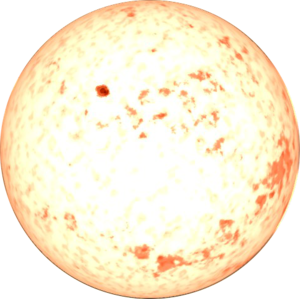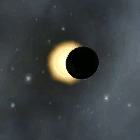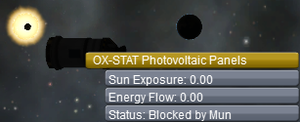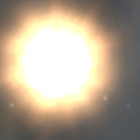Difference between revisions of "Light"
Octachoron (talk | contribs) (Grammar fixes, Clarification and Expansion. Included formula for angular diameter) |
m (Reverted edits by Rocketing Rudolph (talk) to last revision by NWM) |
||
| (6 intermediate revisions by 6 users not shown) | |||
| Line 9: | Line 9: | ||
== Eclipse == | == Eclipse == | ||
[[File:Sun eclipse by Kerbin.gif|thumb|left|Kerbin eclipses Kerbol]] | [[File:Sun eclipse by Kerbin.gif|thumb|left|Kerbin eclipses Kerbol]] | ||
| + | [[File:Partially eclipsed solar panel.png|thumb|A solar panel not working in Mun's partial shadow]] | ||
[[File:Kerbol shine.png|thumb|left|The same view shortly after the eclipse]] | [[File:Kerbol shine.png|thumb|left|The same view shortly after the eclipse]] | ||
| − | |||
| − | Eclipses happen when a celestial body passes in front of Kerbol blocking it fully or partially. As of {{Check version|0. | + | Eclipses happen when a celestial body passes in front of Kerbol blocking it fully or partially. As of {{Check version|1.0.5}} it doesn't get dark if Kerbol is blocked by a body which isn't the source of the sphere of influence the craft is in. To determine how complete a body will eclipse Kerbol the [[w:Angular diameter|angular or apparent diameter]] (δ) of Kerbol and the eclipsing body must be considered. To calculate the angular diameter of a body the distance to the observer (d) and the radius (r) must be known. The apparent diameter represents the angle the eye have to turn to look from one side of an object to another. The formula to calculate this for a sphere is: <math>\delta = 2 \cdot arcsin\left(\frac{r}{d}\right)</math> |
| − | |||
| − | |||
| − | |||
| − | |||
| − | |||
A body can fully eclipse Kerbol only if it is at least close enough to the observer to appear as large as Kerbol. From [[Kerbin]]'s surface the [[Mun]] has an apparent diameter of 1.91° and Kerbol is about 2.20°, so the Mun can almost completely eclipse Kerbol. | A body can fully eclipse Kerbol only if it is at least close enough to the observer to appear as large as Kerbol. From [[Kerbin]]'s surface the [[Mun]] has an apparent diameter of 1.91° and Kerbol is about 2.20°, so the Mun can almost completely eclipse Kerbol. | ||
| − | |||
Unlike the Mun, which has no inclination to its orbit, any moon which has an inclined orbit can cast or receive eclipses only during specific times during the parent planet's orbit around Kerbol. An inclined moon will eclipse Kerbol relative to its parent body, only when that moon's ascending and descending nodes relative to the planet's orbital plane are aligned with any part of the sun. | Unlike the Mun, which has no inclination to its orbit, any moon which has an inclined orbit can cast or receive eclipses only during specific times during the parent planet's orbit around Kerbol. An inclined moon will eclipse Kerbol relative to its parent body, only when that moon's ascending and descending nodes relative to the planet's orbital plane are aligned with any part of the sun. | ||
| − | The synodic period is the length of time it takes for a moon to reach the same position in a planet's sky relative to the planet's sun. For example, the time between two full moons or two new moons represents the synodic period. In the case of Kerbin and Mun, with it's inclination of 0, the time between two total eclipses or two Munar eclipses is the synodic period. If the orbit of the moon is inclined not every orbit results in an eclipse, therefore the time between eclipses is an exact multiple of the synodic period. | + | The synodic period is the length of time it takes for a moon to reach the same position in a planet's sky relative to the planet's sun. For example, the time between two full moons or two new moons represents the synodic period. In the case of Kerbin and Mun, with it's inclination of 0, the time between two total eclipses or two Munar eclipses is the synodic period. If the orbit of the moon is inclined not every orbit results in an eclipse, therefore the time between eclipses is an exact multiple of the synodic period. The first eclipse visible from KSC is at Year 1, Day 18, 4:40. |
Partial and total eclipses will hide the outshine effect shown on the left.<sup>[''specify when it is partially'']</sup> Until the effect disappears and the moon or planet is visible in front of Kerbol, solar panels won't generate electricity. | Partial and total eclipses will hide the outshine effect shown on the left.<sup>[''specify when it is partially'']</sup> Until the effect disappears and the moon or planet is visible in front of Kerbol, solar panels won't generate electricity. | ||
== Intensity == | == Intensity == | ||
| − | The intensity of the light varies depending on the distance. | + | The intensity of the light varies depending on the distance. As in the real-word it follows the [[w:Inverse-square law|inverse-square law]], resulting in four times the intensity when halving the distance. |
{| class="wikitable" | {| class="wikitable" | ||
! Distance (m) | ! Distance (m) | ||
! Power | ! Power | ||
| − | ! | + | ! Comment |
| + | |- | ||
| + | | 5,263,138,304 | ||
| + | | 6.68x | ||
| + | | [[Moho]]'s semi-major axis | ||
|- | |- | ||
| − | | | + | | 9,832,684,544 |
| − | | | + | | 1.91x |
| − | | | + | | [[Eve]]'s semi-major axis |
|- | |- | ||
| 13,599,840,256 | | 13,599,840,256 | ||
| − | | | + | | 1x |
| [[Kerbin]]'s orbit | | [[Kerbin]]'s orbit | ||
| + | |- | ||
| + | | 20,726,155,264 | ||
| + | | 0.431x | ||
| + | | [[Duna]]'s semi-major axis | ||
| + | |- | ||
| + | | 40,839,348,203 | ||
| + | | 0.111x | ||
| + | | [[Dres]]'s semi-major axis | ||
|- | |- | ||
| 68,773,560,320 | | 68,773,560,320 | ||
| − | | 0. | + | | 0.0391x |
| [[Jool]]'s semi-major axis | | [[Jool]]'s semi-major axis | ||
|- | |- | ||
| − | | | + | | 90,118,820,000 |
| − | | | + | | 0.0228x |
| − | | | + | | [[Eeloo]]'s semi-major axis |
| + | |- | ||
| + | | 135,998,402,560 | ||
| + | | 0.01x | ||
| + | | Over 20 Gm beyond Eeloo's apoapsis. | ||
| + | |- | ||
| + | | 430,064,710,234 | ||
| + | | 0.001x | ||
| + | | Very very far away. | ||
|} | |} | ||
== See also == | == See also == | ||
* [[Orbit darkness time]] | * [[Orbit darkness time]] | ||
Latest revision as of 18:26, 17 March 2017

Light makes celestial bodies and parts visible to the human eye and thus the player. There are two sources of light:
- Natural
- Artificial
There is currently only one natural source of light, which is Kerbol, the central star of the Kerbol System. It can power solar panels which generate electric charge. It is also possible to add artificial sources of light like electric lights to make parts of it visible while being in the shadow. All celestial bodies, except for Kerbol, throw a shadow behind them which is perceived as night when being on the surface.
Eclipse
Eclipses happen when a celestial body passes in front of Kerbol blocking it fully or partially. As of 1.0.5[outdated] it doesn't get dark if Kerbol is blocked by a body which isn't the source of the sphere of influence the craft is in. To determine how complete a body will eclipse Kerbol the angular or apparent diameter (δ) of Kerbol and the eclipsing body must be considered. To calculate the angular diameter of a body the distance to the observer (d) and the radius (r) must be known. The apparent diameter represents the angle the eye have to turn to look from one side of an object to another. The formula to calculate this for a sphere is:
A body can fully eclipse Kerbol only if it is at least close enough to the observer to appear as large as Kerbol. From Kerbin's surface the Mun has an apparent diameter of 1.91° and Kerbol is about 2.20°, so the Mun can almost completely eclipse Kerbol.
Unlike the Mun, which has no inclination to its orbit, any moon which has an inclined orbit can cast or receive eclipses only during specific times during the parent planet's orbit around Kerbol. An inclined moon will eclipse Kerbol relative to its parent body, only when that moon's ascending and descending nodes relative to the planet's orbital plane are aligned with any part of the sun.
The synodic period is the length of time it takes for a moon to reach the same position in a planet's sky relative to the planet's sun. For example, the time between two full moons or two new moons represents the synodic period. In the case of Kerbin and Mun, with it's inclination of 0, the time between two total eclipses or two Munar eclipses is the synodic period. If the orbit of the moon is inclined not every orbit results in an eclipse, therefore the time between eclipses is an exact multiple of the synodic period. The first eclipse visible from KSC is at Year 1, Day 18, 4:40.
Partial and total eclipses will hide the outshine effect shown on the left.[specify when it is partially] Until the effect disappears and the moon or planet is visible in front of Kerbol, solar panels won't generate electricity.
Intensity
The intensity of the light varies depending on the distance. As in the real-word it follows the inverse-square law, resulting in four times the intensity when halving the distance.
| Distance (m) | Power | Comment |
|---|---|---|
| 5,263,138,304 | 6.68x | Moho's semi-major axis |
| 9,832,684,544 | 1.91x | Eve's semi-major axis |
| 13,599,840,256 | 1x | Kerbin's orbit |
| 20,726,155,264 | 0.431x | Duna's semi-major axis |
| 40,839,348,203 | 0.111x | Dres's semi-major axis |
| 68,773,560,320 | 0.0391x | Jool's semi-major axis |
| 90,118,820,000 | 0.0228x | Eeloo's semi-major axis |
| 135,998,402,560 | 0.01x | Over 20 Gm beyond Eeloo's apoapsis. |
| 430,064,710,234 | 0.001x | Very very far away. |



